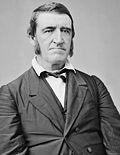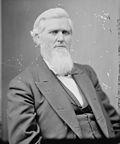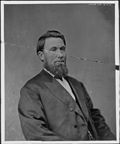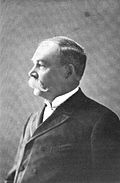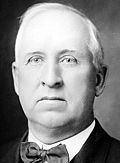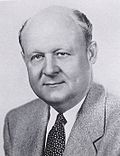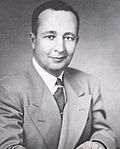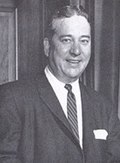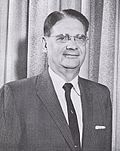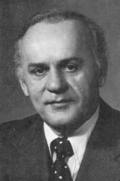Top Qs
Timeline
Chat
Perspective
List of governors of Nebraska
From Wikipedia, the free encyclopedia
Remove ads
The governor of Nebraska is the head of government of the U.S. state of Nebraska as provided by the fourth article of the Constitution of Nebraska. The officeholder is elected to a four-year term, with elections held two years after presidential elections. The governor may be elected any number of times, but not more than twice in a row. The current officeholder is Jim Pillen, a Republican, who was sworn in on January 5, 2023.
Governors of Nebraska must be at least 30 years old and have been citizens and residents of the state for five years before being elected. Before 1966, the governor was elected to a two-year term. In 1962, a constitutional amendment extended the gubernatorial term to four years, effective with the 1966 election. In 1966, another amendment imposed a term limit of two consecutive terms. The lieutenant governor is subject to the same limitations and runs on a combined ticket with the governor. Charles W. Bryan is the only Governor of Nebraska to serve non-consecutive terms. Dave Heineman holds the record as Nebraska's longest-serving governor with 10 years.
The governor's term, along with all other elected statewide officers, begins on the first Thursday after the first Tuesday in the month of January after an election.[2] If the governor becomes incapacitated or is out of the state, the lieutenant governor acts as governor; if there is a vacancy or permanent incapacitation, the lieutenant governor becomes governor and serves the balance of the term. However, if both offices become vacant, the next person in the line of succession is the Speaker of the Nebraska Legislature, who is then followed by the chairs of various committees in the legislature.
Remove ads
List of governors
Summarize
Perspective
Nebraska Territory
Nebraska Territory was organized on May 30, 1854.[3] It had five governors appointed by the president of the United States.
On July 26, 1853, William Walker was elected provisional governor of Nebraska Territory; this spurred the federal government into action to organize the territory.
State of Nebraska
Nebraska was admitted to the Union on March 1, 1867.[20]
Remove ads
Timeline
| Timeline of Nebraska governors |
 |
See also
Notes
- The range given is from the date the governor was confirmed by the Senate, or appointed by the President during a Senate recess, to the date the governor left office.
- Burt died two days after being sworn in; Territorial Secretary Thomas B. Cuming acted as governor until Burt's successor arrived in the territory.[4]
- Izard resigned due to political pressure from the president; Territorial Secretary Thomas B. Cuming acted as governor until Izard's successor arrived in the territory.[9]
- Richardson resigned due to political issues between him and President James Buchanan; Territorial Secretary Julius Sterling Morton acted as governor until Richardson's successor arrived in the territory.[11]
- Black resigned, anticipating removal by the newly-elected president Abraham Lincoln;[13] Lincoln's nomination of his successor specifies "vice Samuel L. Black, removed".[16] Territorial Secretary Julius Sterling Morton and later Territorial Secretary Algernon S. Paddock acted as governor until Black's successor arrived in the territory.[13]
- The office of lieutenant governor was created in 1875.
- Lieutenant governors represented the same party as their governor unless noted.
- Thayer was not a candidate in the 1890 election, which Boyd won, and was due to be sworn in on January 8, 1891. However, Thayer challenged Boyd's citizenship, and thus eligibility to be governor, which delayed his inauguration until January 15. The Supreme Court of Nebraska then ruled that Boyd was ineligible, and Thayer took office again on May 5; however, the Supreme Court of the United States later ruled that Boyd was eligible, and he took office on February 8, 1892.[40][43]
- Represented the Republican Party
- Poynter represented a fusion of the Democratic, Populist, and Silver Republican parties.[54]
- Dietrich resigned, having been elected to the United States Senate.[57]
- Shallenberger lost the Democratic nomination to James Dahlman.[69]
- Represented the Democratic Party
- Bryan was renominated for governor, but withdrew to run unsuccessfully for Vice President of the United States.[84]
- Bryan instead ran unsuccessfully for the Democratic nomination to the United States Senate.[84]
- Cochran instead ran unsuccessfully for the United States Senate.[94]
- Peterson instead ran unsuccessfully for the Republican nomination to the United States Senate.[100]
- Crosby instead ran unsuccessfully for the Republican nomination to the United States Senate.[103]
- Morrison instead ran unsuccessfully for the United States Senate;[115] it is not known if the new gubernatorial term limit would have applied to him.
- Johanns resigned, having been confirmed as United States Secretary of Agriculture.[133]
- Pillen's term will expire on January 7, 2027.
Remove ads
References
External links
Wikiwand - on
Seamless Wikipedia browsing. On steroids.
Remove ads





